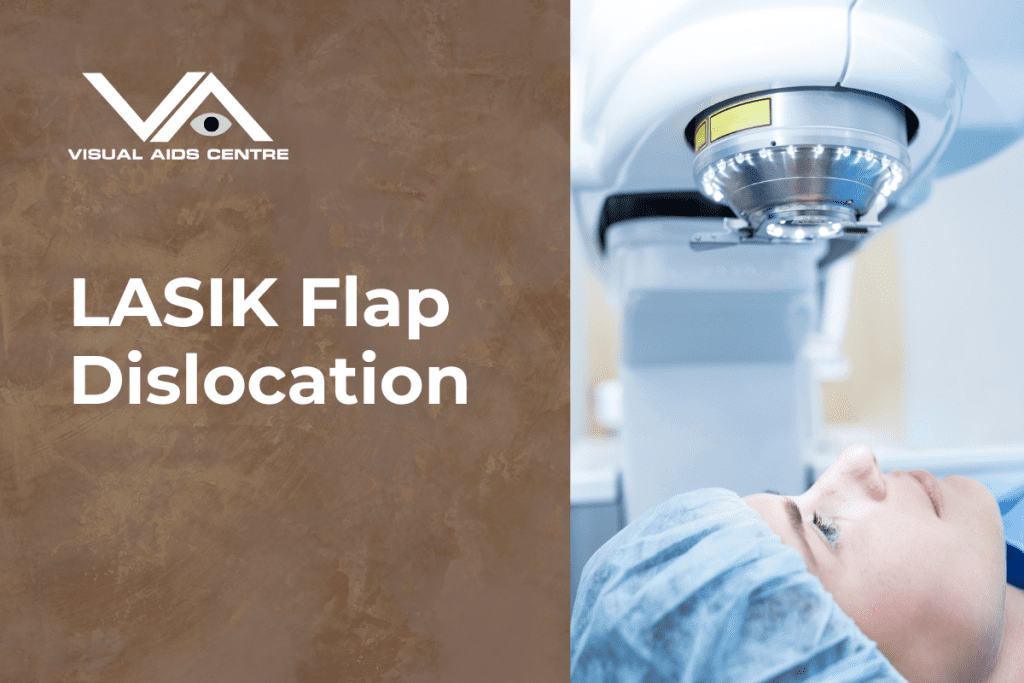Table of Contents
ToggleLASIK surgery has provided millions with the opportunity to live without the need for glasses or contact lenses. Yet, with any surgical procedure, there are potential complications. One such complication is the displacement, or dislocation, of the corneal flap that is created during the LASIK procedure.
This article aims to shed light on the causes, symptoms, and treatment of LASIK flap dislocation, equipping patients, ophthalmologists, and eye care professionals with valuable information about this condition.

What is LASIK Flap Dislocation?
What is the LASIK Flap?
During the LASIK (Laser-Assisted In Situ Keratomileusis) procedure, a precise and specialized laser creates a thin corneal flap on the surface of the eye, which is then lifted to allow another laser to reshape the underlying corneal tissue. Following this reshaping, the flap is repositioned back onto the cornea without stitches. This flap adheres naturally to the underlying tissue during the healing process.
How Does Flap Dislocation Occur?
Dislocation of the LASIK flap, though rare, can occur when the flap moves from its intended position, loses its attachment to the underlying corneal stroma and becomes dislodged leading to various vision problems and discomfort. This dislodgement can be partial or complete. A partial dislocation means only a portion of the flap is lifted, while a complete dislocation involves the entire flap becoming detached.
Flap dislocations can happen shortly after surgery during the initial healing phase, or even years later due to an eye injury or trauma.
Causes of Flap Dislocation
There are several factors that can contribute to the risk of flap dislocation:
- Eye Rubbing: Vigorous eye rubbing soon after surgery can lead to flap displacement.
- Trauma: Blunt force or trauma to the eye area might displace the flap, even if it happens weeks or months after the procedure.
- Dry Eyes: Prolonged dry eye conditions may weaken the bond between the corneal flap and stroma, elevating the risk of dislocation.
- Incomplete Adhesion: In some cases, the flap may not adhere properly to the underlying stroma.
- Incomplete Healing: If the corneal tissue doesn’t heal as expected, the flap can be more prone to dislocation.
- High-impact sports or activities without proper eye protection: This could also pose a significant risk to the stability of the corneal flap and overall ocular health, potentially compromising the surgical outcome.
- Underlying Corneal Conditions: Individuals with thin corneas or specific corneal irregularities may face a greater risk of flap dislocation.
Symptoms of a Dislocated Flap
Patients experiencing LASIK flap dislocation may notice the following symptoms:
- Sudden blurred vision or visual distortion
- Unusual discomfort or severe pain in the eye
- The sensation of something being in the eye (foreign body sensation)
- Redness and tearing
- Increased sensitivity to light
If any of these symptoms occur after LASIK surgery, it’s crucial to contact an eye care professional immediately.
Treatment and Recovery
The treatment for a dislocated LASIK flap typically involves a surgical procedure called a flap repositioning or a flap lift. It generally involves:
- Immediate consultation with an ophthalmologist is crucial to prevent further displacement and minimize the risk of complications.
- Following the administration of a local anaesthetic, the ophthalmologist delicately lifts and repositions the dislocated flap to its appropriate position on the cornea.
- The flap is smoothed out to remove any wrinkles or folds that could lead to irregular astigmatism.
- A bandage contact lens may be placed on the eye to promote healing and comfort.
- Antibiotics and anti-inflammatory medications may be prescribed to prevent infection and aid healing.
- Close monitoring of the healing process is essential, with follow-up appointments to ensure proper adherence and recovery of the cornea.
- In certain instances, additional procedures may be required, including the use of sutures or specialized solutions to secure the flap.
The success of the treatment largely depends on how quickly the condition is addressed. Prompt medical attention can greatly increase the likelihood of restoring clear vision and minimizing long-term effects on vision.
Prevention of Flap Dislocations:
- Abstain from eye rubbing, especially within the first few months after LASIK.
- Avoid strenuous activities that elevate the pressure in your head, such as weightlifting or intense bending, for a minimum of one week post-surgery.
- Use protective eyewear during sports or activities that could lead to eye injury, even years after LASIK.
- Wear a protective shield over the eye, especially during sleep to prevent accidental rubbing.s
- Make sure to attend all your scheduled follow-up appointments with your eye care provider.
Knowledge is Power for a Smooth LASIK Recovery
While LASIK flap dislocation is an uncommon occurrence, understanding the condition is crucial for patients who undergo LASIK surgery and for the eye care professionals who care for them. Recognizing the symptoms and seeking immediate expert care are key steps in addressing this complication effectively.
By staying informed and taking preventative measures, patients can enjoy the benefits of LASIK and maintain the health and safety of their eyes. If you have concerns or questions about LASIK surgery, consult with a qualified ophthalmologist to discuss the risks and rewards in the context of your personal eye health.
Remember to prioritize your eye health and safety post-LASIK, and enjoy the newfound clarity that LASIK has to offer.













